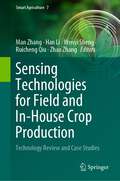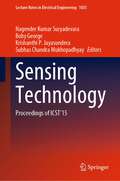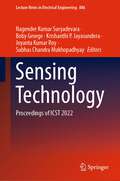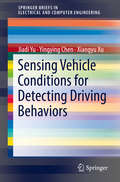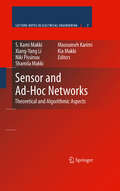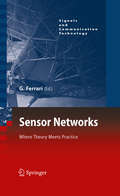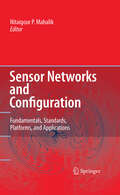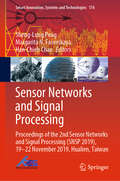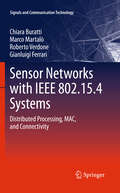- Table View
- List View
Sensing Technologies for Field and In-House Crop Production: Technology Review and Case Studies (Smart Agriculture #7)
by Man Zhang Han Li Wenyi Sheng Ruicheng Qiu Zhao ZhangThis book focuses on state-of-the-art sensing and automation technologies for field crops and in-house product production and provides a lot of innovative knowledge on image processing, AI algorithms and applications in agriculture, and robotics. This book provides undergraduate or graduate students with take-away knowledge for unmanned agricultural production, including but not limited to corn disease detection, wheat head detection and counting, and soil nutrient condition monitoring. The first three chapters focus on reviewing plant phenotyping sensing technology and robotics and soil nutrient monitoring, followed by in-house crop sensing robotics. Then two case studies on corn and the other two case studies on wheat are presented.
Sensing Technology: Proceedings of ICST'15 (Lecture Notes in Electrical Engineering #1035)
by Nagender Kumar Suryadevara Boby George Krishanthi P. Jayasundera Subhas Chandra MukhopadhyayThis book gathers the latest advances, innovations, and applications in the field of sensing technology, as presented by international researchers and engineers at the 15th International Conference on Sensing Technology (ICST), held in Sydney, Australia on December 5–7, 2022. Contributions include a wide range of topics such as: vision sensing, sensor signal processing, sensors phenomena and modelling, sensor characterization, smart sensors and sensor fusion, electromagnetic, chemical and physical sensors, electronic nose technology, biosensors, nano sensors, wireless sensors and WSN, Internet of Things, optical sensors, sensor arrays, intelligent sensing, Internet-based and remote data acquisition. The contributions, which were selected by means of a rigorous international peer-review process, present a wealth of exciting ideas that will open novel research directions and foster multidisciplinary collaboration among different specialists.
Sensing Technology: Proceedings of ICST 2022 (Lecture Notes in Electrical Engineering #886)
by Nagender Kumar Suryadevara Boby George Krishanthi P. Jayasundera Joyanta Kumar Roy Subhas Chandra MukhopadhyayThis book gathers the latest advances, innovations, and applications in the field of sensing technology, as presented by international researchers and engineers at the 14th International Conference on Sensing Technology (ICST), held in Chennai, India on January 17-19, 2022. Contributions include a wide range of topics such as: vision sensing, sensor signal processing, sensors phenomena and modelling, sensor characterization, smart sensors and sensor fusion, electromagnetic, chemical and physical sensors, electronic nose technology, biosensors, nano sensors, wireless sensors and WSN, Internet of Things, optical sensors, sensor arrays, intelligent sensing, Internet-based and remote data acquisition. The contributions, which were selected by means of a rigorous international peer-review process, present a wealth of exciting ideas that will open novel research directions and foster multidisciplinary collaboration among different specialists.
Sensing Vehicle Conditions for Detecting Driving Behaviors (SpringerBriefs in Electrical and Computer Engineering)
by Jiadi Yu Yingying Chen Xiangyu XuThis SpringerBrief begins by introducing the concept of smartphone sensing and summarizing the main tasks of applying smartphone sensing in vehicles. Chapter 2 describes the vehicle dynamics sensing model that exploits the raw data of motion sensors (i.e., accelerometer and gyroscope) to give the dynamic of vehicles, including stopping, turning, changing lanes, driving on uneven road, etc. Chapter 3 detects the abnormal driving behaviors based on sensing vehicle dynamics. Specifically, this brief proposes a machine learning-based fine-grained abnormal driving behavior detection and identification system, D3, to perform real-time high-accurate abnormal driving behaviors monitoring using the built-in motion sensors in smartphones.As more vehicles taking part in the transportation system in recent years, driving or taking vehicles have become an inseparable part of our daily life. However, increasing vehicles on the roads bring more traffic issues including crashes and congestions, which make it necessary to sense vehicle dynamics and detect driving behaviors for drivers. For example, sensing lane information of vehicles in real time can be assisted with the navigators to avoid unnecessary detours, and acquiring instant vehicle speed is desirable to many important vehicular applications. Moreover, if the driving behaviors of drivers, like inattentive and drunk driver, can be detected and warned in time, a large part of traffic accidents can be prevented. However, for sensing vehicle dynamics and detecting driving behaviors, traditional approaches are grounded on the built-in infrastructure in vehicles such as infrared sensors and radars, or additional hardware like EEG devices and alcohol sensors, which involves high cost. The authors illustrate that smartphone sensing technology, which involves sensors embedded in smartphones (including the accelerometer, gyroscope, speaker, microphone, etc.), can be applied in sensing vehicle dynamics and driving behaviors. Chapter 4 exploits the feasibility to recognize abnormal driving events of drivers at early stage. Specifically, the authors develop an Early Recognition system, ER, which recognize inattentive driving events at an early stage and alert drivers timely leveraging built-in audio devices on smartphones. An overview of the state-of-the-art research is presented in chapter 5. Finally, the conclusions and future directions are provided in Chapter 6.
Sensitivity Analysis for Business, Technology, and Policymaking: Made Easy with Simulation Decomposition (SimDec) (Routledge Open Business and Economics)
by Mariia Kozlova Julian Scott YeomansSimDec is a revolution in decision-making support. SimDec “teases out” inherent cause-and-effect relationships and reveals the intricacy of relationships between sets of input and output variables. At its core, SimDec is an amalgamation of uncertainty and global sensitivity analysis with an innovative visualization technique. While straightforward and elegant, this novel approach significantly enhances the analytical capabilities of users by readily exposing seemingly, a priori, counterintuitive behaviours so that they can be readily understood by both technical specialists and non-technical users alike.This book is the first to articulate the ubiquitous applicability of SimDec and has been written by the leading proponents of the technique. The book provides the necessary background to fully understand the underlying approach and then demonstrates its applicability to a wide spectrum of fields, such as finance, entrepreneurship, energy, 3D manufacturing, geology, the environment, engineering, public policy, and even superconducting magnets. To facilitate as widespread adoption and penetration of SimDec as possible, all supporting computer codes are available, open-source, in Python, Julia, R, and Matlab.The innovative material will be of primary benefit to practitioners and researchers analyzing data from the social sciences, business, science, engineering, mathematics, and computing.The Open Access version of this book, available at http://www.taylorfrancis.com, has been made available under a Creative Commons [Attribution-Non Commercial-No Derivatives (CC-BY-NC-ND)] 4.0 license.
Sensitivity Analysis for Business, Technology, and Policymaking: Made Easy with Simulation Decomposition (SimDec) (Routledge Open Business and Economics)
SimDec is a revolution in decision-making support. SimDec “teases out” inherent cause-and-effect relationships and reveals the intricacy of relationships between sets of input and output variables. At its core, SimDec is an amalgamation of uncertainty and global sensitivity analysis with an innovative visualization technique. While straightforward and elegant, this novel approach significantly enhances the analytical capabilities of users by readily exposing seemingly, a priori, counterintuitive behaviours so that they can be readily understood by both technical specialists and non-technical users alike.This book is the first to articulate the ubiquitous applicability of SimDec and has been written by the leading proponents of the technique. The book provides the necessary background to fully understand the underlying approach and then demonstrates its applicability to a wide spectrum of fields, such as finance, entrepreneurship, energy, 3D manufacturing, geology, the environment, engineering, public policy, and even superconducting magnets. To facilitate as widespread adoption and penetration of SimDec as possible, all supporting computer codes are available, open-source, in Python, Julia, R, and Matlab.The innovative material will be of primary benefit to practitioners and researchers analyzing data from the social sciences, business, science, engineering, mathematics, and computing.The Open Access version of this book, available at http://www.taylorfrancis.com, has been made available under a Creative Commons [Attribution-Non Commercial-No Derivatives (CC-BY-NC-ND)] 4.0 license.
Sensitivity Analysis for Neural Networks (Natural Computing Series)
by Daniel S. Yeung Ian Cloete Daming Shi Wing W. NgArtificial neural networks are used to model systems that receive inputs and produce outputs. The relationships between the inputs and outputs and the representation parameters are critical issues in the design of related engineering systems, and sensitivity analysis concerns methods for analyzing these relationships. Perturbations of neural networks are caused by machine imprecision, and they can be simulated by embedding disturbances in the original inputs or connection weights, allowing us to study the characteristics of a function under small perturbations of its parameters. This is the first book to present a systematic description of sensitivity analysis methods for artificial neural networks. It covers sensitivity analysis of multilayer perceptron neural networks and radial basis function neural networks, two widely used models in the machine learning field. The authors examine the applications of such analysis in tasks such as feature selection, sample reduction, and network optimization. The book will be useful for engineers applying neural network sensitivity analysis to solve practical problems, and for researchers interested in foundational problems in neural networks.
Sensor-Actuator Supported Implicit Interaction in Driver Assistance Systems
by Andreas RienerAndreas Riener studies the influence of implicit interaction using vibro-tactile actuators as additional sensory channels for car-driver feedback and pressure sensor arrays for implicit information transmission from the driver toward the vehicle. The results of his experiments suggest the use of both vibro-tactile notifications and pressure sensor images to improve vehicle handling performance and to decrease the driver’s cognitive workload.
Sensor and Ad-Hoc Networks: Theoretical and Algorithmic Aspects (Lecture Notes in Electrical Engineering #7)
by Xiang-Yang Li Kia Makki S. Kami Makki Niki Pissinou Masoumeh Karimi Shamila MakkiThis book brings together leading researchers and developers in the field of wireless sensor networks to explain the special problems and challenges of the algorithmic aspects of sensor and ad-hoc networks. The book also fosters communication not only between the different sensor and ad-hoc communities, but also between those communities and the distributed systems and information systems communities. The topics addressed pertain to the sensors and mobile environment.
Sensor- and Video-Based Activity and Behavior Computing: Proceedings of 3rd International Conference on Activity and Behavior Computing (ABC 2021) (Smart Innovation, Systems and Technologies #291)
by Md Atiqur Rahman Ahad Sozo Inoue Daniel Roggen Kaori FujinamiThis book presents the best-selected research papers presented at the 3rd International Conference on Activity and Behavior Computing (ABC 2021), during 20–22 October 2021. The book includes works related to the field of vision- and sensor-based human action or activity and behavior analysis and recognition. It covers human activity recognition (HAR), action understanding, gait analysis, gesture recognition, behavior analysis, emotion, and affective computing, and related areas. The book addresses various challenges and aspects of human activity recognition—both in sensor-based and vision-based domains. It can be considered as an excellent treasury related to the human activity and behavior computing.
Sensor Applications, Experimentation, and Logistics: First International Conference, SENSAPPEAL 2009, Athens, Greece, September 25, 2009, Revised Selected Papers (Lecture Notes of the Institute for Computer Sciences, Social Informatics and Telecommunications Engineering #29)
by Nikos KomninosWireless sensor networks (WSNs) are envisioned to enable a variety of applications including environmental monitoring, building and plant automation, homeland se- rity and healthcare. It has been argued that one of the key characteristics of sensor networks is that they are tightly coupled with the applications running on top of them. Although WSNs have been an active area of research for over a decade, real world sensor network deployments have not yet found their way to widespread adoption. The experience gained and lessons learned during the initial attempts to deploy WSNs and implement various sensor network applications are very valuable for the - vancement of this technology. Recognizing the need of a conference dedicated to practical aspects of WSN p- taining to their employment in a plethora of applications, ICST launched SENSAPPEAL as a yearly event whose first edition took place in September 2009 at the Athens Information Technology campus in the outskirts of Athens, Greece.
Sensor Based Intelligent Robots: International Workshop Dagstuhl Castle, Germany, September 28 - October 2, 1998 Selected Papers (Lecture Notes in Computer Science #1724)
by Henrik I. Christensen Horst Bunke Hartmut NoltemeierSensor Based Intelligent Robots: International Workshop, Dagstuhl Castle, Germany, October 15-20, 2000. Selected Revised Papers (Lecture Notes in Computer Science #2238)
by Gregory D. Hager Henrik I. Christensen Horst Bunke Rolf KleinRobotics is a highly interdisciplinary research topic, that requires integration of methods for mechanics, control engineering, signal processing, planning, gra- ics, human-computer interaction, real-time systems, applied mathematics, and software engineering to enable construction of fully operational systems. The diversity of topics needed to design, implement, and deploy such systems implies that it is almost impossible for individual teams to provide the needed critical mass for such endeavors. To facilitate interaction and progress on sensor-based intelligent robotics inter-disciplinary workshops are necessary through which - depthdiscussioncanbeusedforcrossdisseminationbetweendi?erentdisciplines. The Dagstuhl foundation has organized a number of workshops on Mod- ing and Integration of Sensor Based Intelligent Robot Systems. The Dagstuhl seminars take place over a full week in a beautiful setting in the Saarland in Germany. The setting provides an ideal environment for in-depth presentations and rich interaction between the participants. This volume contains papers presented during the fourth workshop held - tober 15–20, 2000. All papers were submitted by workshop attendees, and were reviewed by at least one reviewer. We wish to thank all of the reviewers for their invaluable help in making this a high-quality selection of papers. We gratefully acknowledge the support of the Schloss Dagstuhl Foundation and the sta? at Springer-Verlag. Without their support the production of this volume would not have been possible.
Sensor-Based Robots: Algorithms and Architectures (NATO ASI Subseries F: #66)
by C. S. George LeeMost industrial robots today have little or no sensory capability. Feedback is limited to information about joint positions, combined with a few interlock and timing signals. These robots can function only in an environment where the objects to be manipulated are precisely located in the proper position for the robot to grasp (i. e. , in a structured environment). For many present industrial applications, this level of performance has been adequate. With the increasing demand for high performance sensor-based robot manipulators in assembly tasks, meeting this demand and challenge can only be achieved through the consideration of: 1) efficient acquisition and processing of intemaVextemal sensory information, 2) utilization and integration of sensory information from various sensors (tactile, force, and vision) to acquire knowledge in a changing environment, 3) exploitation of inherent robotic parallel algorithms and efficient VLSI architectures for robotic computations, and finally 4) system integration into a working and functioning robotic system. This is the intent of the Workshop on Sensor-Based Robots: Algorithms and Architectures - to study the fundamental research issues and problems associated with sensor-based robot manipulators and to propose approaches and solutions from various viewpoints in improving present day robot manipula tors in the areas of sensor fusion and integration, sensory information processing, and parallel algorithms and architectures for robotic computations.
Sensor Devices and Systems for Robotics (NATO ASI Subseries F: #52)
by Alicia CasalsAs robots improve in efficiency and intelligence, there is a growing need to develop more efficient, accurate and powerful sensors in accordance with the tasks to be robotized. This has led to a great increase in the study and development of different kinds of sensor devices and perception systems over the last ten years. Applications that differ from the industrial ones are often more demanding in sensorics since the environment is not usually so well structured. Spatial and agricultural applications are examples of situations where the environment is unknown or variable. Therefore, the work to be done by a robot cannot be strictly programmed and there must be an interactive communication with the environment. It cannot be denied that evolution and development in robotics are closely related to the advances made in sensorics. The first vision and force sensors utilizing discrete components resulted in a very low resolution and poor accuracy. However, progress in VLSI, imaging devices and other technologies have led to the development of more efficient sensor and perception systems which are able to supply the necessary data to robots.
Sensor Networks: 9th International Conference, SENSORNETS 2020, Valletta, Malta, February 28–29, 2020, and 10th International Conference, SENSORNETS 2021, Virtual Event, February 9–10, 2021, Revised Selected Papers (Communications in Computer and Information Science #1674)
by Andreas Ahrens RangaRao Venkatesha Prasad César Benavente-Peces Nirwan AnsariThis book constitutes selected and revised papers of the 9th International Conference, SENSORNETS 2020, Valletta, Malta, held in February 2020, and the 10th International Conference, SENSORNETS 2021, held virtually in February 2021. The 7 full papers presented were carefully reviewed and selected from 60 submissions. They focus in all aspects of sensor networks, including hardware of sensor networks, wireless communication protocols, sensor networks software, hardware and architectures, wireless information networks, channel characterization, data manipulation, signal processing, localization and object tracking through sensor networks, modelling and simulation, applications and uses.
Sensor Networks: 6th International Conference, SENSORNETS 2017, Porto, Portugal, February 19-21, 2017, and 7th International Conference, SENSORNETS 2018, Funchal, Madeira, Portugal, January 22-24, 2018, Revised Selected Papers (Communications in Computer and Information Science #1074)
by César Benavente-Peces Nancy Cam-Winget Eric Fleury Andreas AhrensThis book constitutes the refereed proceedings of the 6th International Conference, SENSORNETS 2017, Porto, Portugal, held in February 2017, and the 7th International Conference, SENSORNETS 2018, Funchal, Madeira, Portugal, held in January 2018. The 18 full papers presented were carefully reviewed and selected from 67 submissions. The papers cover the following topics: sensor networks, including hardware of sensor networks, wireless communication protocols, sensor networks software and architectures, wireless information networks, data manipulation, signal processing, localization and object tracking through sensor networks, obstacles, applications and uses.
Sensor Networks: Where Theory Meets Practice (Signals and Communication Technology)
by Gianluigi FerrariThe idea of this book comes from the observation that sensor networks represent a topic of interest from both theoretical and practical perspectives. The title und- lines that sensor networks offer the unique opportunity of clearly linking theory with practice. In fact, owing to their typical low-cost, academic researchers have the opportunity of implementing sensor network testbeds to check the validity of their theories, algorithms, protocols, etc., in reality. Likewise, a practitioner has the opportunity of understanding what are the principles behind the sensor networks under use and, thus, how to properly tune some accessible network parameters to improve the performance. On the basis of the observations above, the book has been structured in three parts:PartIisdenotedas“Theory,”sincethetopicsofits vechaptersareapparently “detached” from real scenarios; Part II is denoted as “Theory and Practice,” since the topics of its three chapters, altough theoretical, have a clear connection with speci c practical scenarios; Part III is denoted as “Practice,” since the topics of its ve chapters are clearly related to practical applications.
Sensor Networks and Configuration: Fundamentals, Standards, Platforms, and Applications
by Nitaigour P. MahalikThis book incorporates a selection of research and development papers. Its scope is on history and background, underlying design methodology, application domains and recent developments. The readers will be able to understand the underlying technology, philosophy, concepts, ideas, and principles, with regard to broader areas of sensor network. Aspects of sensor network and experimental results have been presented in proper order.
Sensor Networks and Signal Processing: Proceedings of the 2nd Sensor Networks and Signal Processing (SNSP 2019), 19-22 November 2019, Hualien, Taiwan (Smart Innovation, Systems and Technologies #176)
by Sheng-Lung Peng Margarita N. Favorskaya Han-Chieh ChaoThis book offers a collection of high-quality research papers presented at the 2nd International Conference on Sensor Networks and Signal Processing (SNSP 2019), held in Taiwan on November 19–22, 2019. It presents novel contributions in the areas of sensor and actuator networks, wireless networks, networking and protocols, security and privacy, wireless communications, distributed algorithms, Internet of Things, system modeling and performance analysis, fault tolerance/diagnostics, information management, data mining and analysis, embedded systems design, signal theory, signal and image processing, detection and estimation, spectral analysis, software developments, pattern recognition, data processing, remote sensing, big data, machine learning, information and coding theory, and industrial applications.
Sensor Networks with IEEE 802.15.4 Systems: Distributed Processing, MAC, and Connectivity (Signals and Communication Technology)
by Chiara Buratti Marco Martalo' Roberto Verdone Gianluigi FerrariThis book presents a simple, yet complete, approach to the design and performance analysis of distributed processing algorithms and techniques suitable for IEEE 802.15.4 networks. In particular, the book focuses on the bottom two layers of the ISO/OSI stack (Physical and Medium Access Control), discussing also a few issue related to routing. The book is a the synergistic combination of signal processing aspects on the one hand and MAC and connectivity issues on the other hand. The goal of the book is to clearly link physical layer aspects with medium access and topology aspects, in order to provide the reader with a clear understanding of how to approach the design of proper distributed signal processing and medium access algorithms in this context.
Sensor Projects with Raspberry Pi: Internet of Things and Digital Image Processing
by Guillermo GuillenStart solving world issues by beginning small with simple Rasperry Pi projects. Using a free IoT server; tackle fundamental topics and concepts behind the Internet of Things. Image processing and sensor topics aren’t only applicable to the Raspberry Pi. The skills learned in this book can go own to other applications in mobile development and electrical engineering. Start by creating a system to detect movement through the use of a PIR motion sensor and a Raspberry Pi board. Then further your sensor systems by detecting more than simple motion. Use the MQ2 gas sensor and a Raspberry Pi board as a gas leak alarm system to detect dangerous explosive and fire hazards. Train your system to send the captured data to the remote server ThingSpeak. When a gas increase is detected beyond a limit, then a message is sent to your Twitter account. Having started with ThingSpeak, we’ll go on to develop a weather station with your Raspberry Pi. Using the DHT11 (humidity and temperature sensor) and BMP085 (barometric pressure and temperature sensor) in conjunction with ThingSpeak and Twitter, you can receive realtime weather alerts from your own meterological system!Finally, expand your skills into the popular machine learning world of digital image processing using OpenCV and a Pi. Make your own object classifiers and finally manipulate an object by means of an image in movement. This skillset has many applications, ranging from recognizing people or objects, to creating your own video surveillance system.With the skills developed in this book, you will have everything you need to work in IoT projects for the Pi. You can then expand your skills out further to develop mobile projects and delve into interactive systems such as those found in machine learning.What You'll LearnWork with ThingSpeak to receive Twitter alerts from your systemsCultivate skills in processing sensor inputs that are applicable to mobile and machine learning projects as wellIncorporate sensors into projects to make devices that interact with more than just codeWho This Book Is ForHobbyists and makers working robotics and Internet of Things areas will find this book a great resource for quick but expandable projects. Electronics engineers and programmers who would like to expand their familiarity with basic sensor projects will also find this book helpful.
Sensor Projects with Raspberry Pi: Internet of Things and Digital Image Processing (Maker Innovations Series)
by Guillermo GuillenUse Python to develop Rasperry Pi projects to solve common digital image processing and IoT problems. Using a free IoT server you’ll tackle fundamental topics and concepts behind theses two areas. This second edition includes new content on Artificial Intelligence and updated sensor guidance to help you better explore virtual animations, create a homemade spectrometer, and master object classification with Edge Impulse. Start by creating a system to detect movement with a PIR motion sensor and a Raspberry Pi board. Use the MQ2 gas sensor and a Raspberry Pi board as a gas leak alarm system to detect dangerous explosive and fire hazards. Then train your system to send the captured data to the remote server ThingSpeak. You’ll also develop a weather station with your Raspberry Pi. Using the DHT11 (humidity and temperature sensor) and BMP (barometric pressure and temperature sensor) in conjunction with ThingSpeak and X, you can receive real time weather alerts from your own meterological system! Spectral sensers used with the Raspberry Pi include the AS7262 (six colors), and AS7263 (near infrared) for the construction of a filter spectrometer, sensing colored solutions, and assessing plant foliage health. Finally, expand your skills into the popular machine learning world of digital image processing using OpenCV and a Pi. Make your own object classifiers and finally manipulate an object by means of an image in movement. This skillset has many applications, ranging from recognizing people or objects, to creating your own video surveillance system. With the skills gained from Sensor Projects with Raspberry Pi, you'll be well-equipped to explore other applications in mobile development and electrical engineering as well. What You'll Learn Work with ThingSpeak to receive X alerts from your systems. Cultivate skills in processing sensor inputs that are applicable to mobile and machine learning projects. Incorporate sensors into projects to make interactive devices. Experiment with virtual scenarios and objects. Create Python and Pygame games that contain virtual scenarios and animations. Detect colored solutions and assess the plant foliage health. Who This Book Is For Hobbyists and makers working with robotics and IoT. Electronic engineers and programmers who would like to expand their familiarity with basic sensor projects.
Sensor Systems and Software: First International ICST Conference, S-CUBE 2009, Pisa, Italy, September 7-9, 2009, Revised Selected Papers (Lecture Notes of the Institute for Computer Sciences, Social Informatics and Telecommunications Engineering #24)
by Stephen Hailes Sabrina Sicari George RoussosThe First International ICST Conference on Sensor Systems and Software (S-cube 2009) was held during 7–8 September in Pisa, Italy. This new international conference was dedicated to addressing the research challenges facing system dev- opment and software support for systems based on wireless sensor networks (WSNs) that have the potential to impact society in many ways. Currently, wireless sensor networks introduce innovative and interesting application scenarios that may support a large amount of different applications including environmental monitoring, disaster prevention, building automation, object tracking, nuclear reactor control, fire det- tion, agriculture, healthcare, and traffic monitoring. The widespread acceptance of these new services can be improved by the definition of frameworks and architectures that have the potential to radically simplify software development for wireless sensor network-based applications. The aim of these new architectures is to support flexible, scalable programming of applications based on adaptive middleware. As a con- quence, WSNs require novel programming paradigms and technologies. Moreover, the design of new complex systems, characterized by the interaction of different and heterogeneous resources, will allow the development of innovative applications that meet high-performance goals. Hence, WSNs require contributions from many fields such as embedded systems, distributed systems, data management, system security and applications. The conference places emphasis on layers well above the traditional MAC and routing and transport layer protocols.
Sensor Systems and Software: 5th International Conference, S-CUBE 2014, Coventry, UK, October 6-7, 2014, Revised Selected Papers (Lecture Notes of the Institute for Computer Sciences, Social Informatics and Telecommunications Engineering #143)
by Eiman Kanjo Dirk TrossenThis book constitutes the thoroughly refereed post-conference proceedings of the 5th International Conference on Sensor Systems and Software, S-Cube 2014, held in Coventry, UK, in October 2014. The 12 revised full papers presented were selected from 16 submissions and cover technologies for wireless sensor networks, including security protocols, middleware, analysis tools and frameworks.
